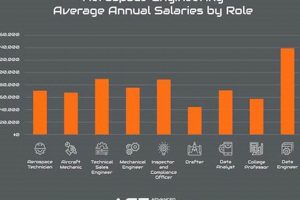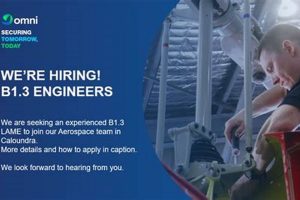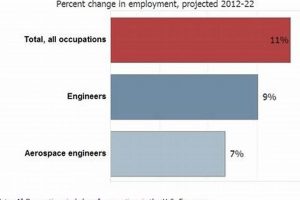The combination of professional roles centers on individuals with expertise in the design, development, testing, and maintenance of aircraft and spacecraft, coupled with employment opportunities within the National Aeronautics and Space Administration. These positions involve applying engineering principles to advance space exploration and aeronautical research.
These career paths are vital for advancing scientific knowledge, developing cutting-edge technologies, and ensuring the safety and efficiency of space missions and air travel. Historically, individuals in these roles have been instrumental in landmark achievements such as the Apollo program, the development of the Space Shuttle, and ongoing projects aimed at exploring Mars and beyond.
This article will explore the diverse responsibilities within these positions, the qualifications typically required, and the pathways to securing employment in related fields.
Strategies for Pursuing Related Career Opportunities
Effective planning and preparation are crucial for individuals seeking employment in these highly competitive positions. The following guidelines provide actionable strategies to enhance candidacy and maximize opportunities.
Tip 1: Obtain a Relevant Educational Foundation: A bachelor’s or master’s degree in aerospace engineering, or a closely related field such as mechanical or electrical engineering, is typically required. Coursework should emphasize areas like aerodynamics, propulsion, orbital mechanics, and materials science.
Tip 2: Cultivate Specialized Skills: Proficiency in industry-standard software such as MATLAB, CAD (Computer-Aided Design) programs like SolidWorks or CATIA, and simulation tools is essential. Demonstrated experience with these tools through projects or internships significantly strengthens a candidate’s profile.
Tip 3: Secure Relevant Internship Experience: Internships at NASA centers, aerospace companies, or research institutions provide invaluable hands-on experience and networking opportunities. These experiences demonstrate practical application of theoretical knowledge and commitment to the field.
Tip 4: Develop a Strong Technical Portfolio: Showcase engineering projects, research papers, and design work in a well-organized portfolio. This portfolio serves as a tangible demonstration of skills and abilities to potential employers.
Tip 5: Network Actively: Attend industry conferences, join professional organizations such as the American Institute of Aeronautics and Astronautics (AIAA), and connect with engineers and recruiters. Networking expands professional contacts and provides insights into current opportunities.
Tip 6: Tailor Applications to Specific Positions: Carefully review job descriptions and customize resumes and cover letters to highlight relevant skills and experience. Emphasize how qualifications align with the specific requirements of each position.
Tip 7: Prepare Thoroughly for Technical Interviews: Expect rigorous technical interviews that assess problem-solving abilities, knowledge of engineering principles, and experience with relevant technologies. Practice answering technical questions and be prepared to discuss past projects in detail.
Tip 8: Consider Advanced Education: For certain specialized roles, a Ph.D. may be required or highly preferred. Advanced degrees demonstrate a commitment to in-depth research and expertise in a specific area of aerospace engineering.
Implementing these strategies increases the likelihood of securing related positions by demonstrating a strong foundation of knowledge, skills, and relevant experience.
The subsequent sections will delve into specific aspects of career progression and ongoing developments within related engineering and scientific communities.
1. Job Availability
Job availability within NASA for professionals trained in aerospace engineering is directly influenced by federal budget allocations, ongoing and projected projects, and the strategic priorities of the agency. Increases in funding for space exploration, aeronautical research, or specific missions like lunar or Martian programs correlate with a rise in the number of positions available. Conversely, budget cuts or program cancellations lead to decreased opportunities. For example, the Space Shuttle program’s conclusion resulted in a contraction of related positions, while the Artemis program is currently driving demand for engineers skilled in areas like propulsion systems and spacecraft design.
The significance of job availability as a component reflects its impact on career prospects and the overall talent pool. A competitive job market demands higher qualifications, specialized skills, and relevant experience from applicants. Understanding these trends allows prospective candidates to strategically align their education and training with anticipated needs. Furthermore, monitoring NASA’s strategic plans and technology roadmaps provides insight into future employment areas, such as in-space manufacturing or advanced materials, enabling targeted skill development. A robust job market also enables the agency to recruit highly qualified personnel, fostering innovation and enhancing the probability of mission success.
In summary, the connection between job availability and potential employment highlights the need for professionals to remain adaptable and informed about funding trends and mission priorities. Monitoring NASA’s announcements, engaging with aerospace industry reports, and acquiring skills relevant to emerging technologies are crucial strategies. This proactive approach enhances prospects and ensures alignment with the dynamic demands of the aerospace sector.
2. Skill Requirements
Possessing the requisite skills is paramount for securing and succeeding in positions at NASA for professionals trained in aerospace engineering. The alignment of an individual’s expertise with the agency’s needs directly influences their competitiveness and ability to contribute to its mission. These skill requirements encompass both technical proficiency and soft skills essential for collaborative problem-solving and innovation.
- Technical Proficiency in Aerospace Engineering Disciplines
A strong foundation in core aerospace engineering disciplines, such as aerodynamics, propulsion, structural analysis, and control systems, is fundamental. For example, engineers designing spacecraft require in-depth knowledge of orbital mechanics, spacecraft dynamics, and thermal management to ensure mission success. Similarly, engineers working on advanced aircraft must possess expertise in computational fluid dynamics and materials science to optimize aerodynamic performance and structural integrity. Mastery of these disciplines enables engineers to contribute effectively to the design, development, and testing of aerospace systems.
- Proficiency in Software and Simulation Tools
Competence in industry-standard software and simulation tools is essential for performing complex analyses and simulations. Examples include CAD (Computer-Aided Design) software like CATIA or SolidWorks for designing aerospace components, finite element analysis (FEA) software like ANSYS for structural analysis, and computational fluid dynamics (CFD) software like Fluent for aerodynamic simulations. Familiarity with programming languages such as MATLAB and Python is also beneficial for data analysis and automation. The ability to leverage these tools enables engineers to model and analyze complex systems, optimize designs, and predict performance under various operating conditions.
- Problem-Solving and Analytical Skills
The ability to analyze complex problems, identify critical issues, and develop innovative solutions is crucial for aerospace engineers at NASA. This includes the ability to apply engineering principles, mathematical models, and scientific methods to solve challenging technical problems. For instance, troubleshooting anomalies during flight tests, developing new algorithms for spacecraft navigation, or optimizing the performance of propulsion systems requires strong analytical and problem-solving skills. The ability to think critically, analyze data, and develop creative solutions is essential for overcoming technical obstacles and advancing the state of the art in aerospace engineering.
- Communication and Teamwork Skills
Effective communication and teamwork skills are essential for collaborating with multidisciplinary teams, communicating technical information to stakeholders, and contributing to a positive and productive work environment. Aerospace projects typically involve large teams of engineers, scientists, and technicians working together to achieve common goals. The ability to communicate technical concepts clearly and concisely, actively listen to others, and work collaboratively to solve problems is essential for ensuring project success. Strong communication and teamwork skills enable engineers to effectively share knowledge, coordinate activities, and contribute to a culture of innovation and collaboration.
These skill requirements are not static; they evolve in response to technological advancements and the changing needs of NASA’s missions. Continuously updating skills and knowledge through professional development, training courses, and participation in industry conferences is crucial for remaining competitive and contributing to the advancement of space exploration and aeronautical research. Mastering these skills enhances the prospects of securing employment within NASA and significantly contributes to the success of its ambitious endeavors.
3. Application Process
The application process constitutes a critical gateway to employment within NASA for individuals specializing in aerospace engineering. Success in securing these positions is heavily contingent upon navigating this process effectively, meeting stringent requirements, and demonstrating qualifications that align with NASA’s mission objectives. The process, often rigorous and highly competitive, serves as the initial evaluation phase, determining which candidates proceed to subsequent stages of consideration.
The application process typically involves several key steps. Initially, prospective applicants must identify suitable vacancies on NASA’s career portal or through federal job boards. Upon selection of a specific position, a detailed application package must be assembled, including a comprehensive resume or curriculum vitae, academic transcripts, letters of recommendation, and a statement of purpose outlining relevant skills, experience, and career goals. A crucial element involves tailoring the application to the specific requirements of each position, highlighting the candidate’s unique qualifications and demonstrating a clear understanding of the role’s responsibilities and NASA’s broader objectives. The USAJOBS website is a common portal for federal government positions, including those at NASA. Therefore, understanding federal resume requirements is vital.
Failing to adhere to these stringent application requirements significantly diminishes a candidate’s prospects. Errors in the application, omissions of required information, or a generic, non-tailored presentation can lead to immediate disqualification. Successful navigation of the application process requires meticulous attention to detail, a thorough understanding of NASA’s mission and values, and a strategic presentation of qualifications that align with the specific demands of the position. Understanding the application process serves as a foundational step toward realizing a career in aerospace engineering within NASA, enabling prospective candidates to strategically position themselves for success.
4. Career Trajectory
The career trajectory for professionals in aerospace engineering roles at NASA is often characterized by progressive advancement through technical or managerial positions, underpinned by experience, specialized skills, and contributions to agency objectives. Entry-level positions typically involve supporting established projects, conducting research under senior engineers, or assisting in the design and testing of components. As individuals gain experience, they may transition to leading smaller teams, managing specific aspects of projects, or specializing in a particular area such as propulsion, avionics, or mission planning. This progression is influenced by factors such as performance evaluations, advanced degrees, and the acquisition of certifications demonstrating expertise.
Examples of career progression include engineers starting as propulsion system analysts and later becoming lead engineers for engine development on a spacecraft program. Another example involves individuals beginning as entry-level structural engineers and advancing to project managers overseeing the structural integrity of space stations or launch vehicles. The importance of a well-defined career trajectory lies in its capacity to provide a framework for skill development, mentorship, and long-term professional growth within the agency. NASA benefits from this as experienced employees contribute directly to advancing its mission objectives.
In conclusion, the career trajectory within NASA aerospace engineering positions represents a pathway for continuous learning and professional development. While influenced by individual capabilities and agency priorities, a clear understanding of potential advancement opportunities enables engineers to strategically plan their careers, acquiring the necessary skills and experience to contribute to NASA’s enduring legacy of space exploration and scientific discovery. The inherent challenges include the need for constant adaptation to technological advancements and the highly competitive nature of promotions, requiring a proactive approach to skill enhancement and networking.
5. Location Factors
Geographic location exerts a considerable influence on aerospace engineering positions within NASA. Proximity to NASA centers is a primary consideration, creating a concentration of opportunities in specific regions. For instance, the Johnson Space Center in Houston, Texas, serves as a hub for human spaceflight activities, resulting in a high demand for engineers specializing in life support systems, mission control, and astronaut training. Similarly, the Marshall Space Flight Center in Huntsville, Alabama, is a focal point for propulsion systems and rocket development, generating a need for engineers with expertise in these areas. This geographic distribution directly impacts job availability and career paths. A candidates willingness to relocate to these key locations significantly increases employment prospects.
Moreover, location influences the cost of living and lifestyle considerations for engineers accepting positions at NASA. Areas near major centers often exhibit higher housing costs and a different pace of life compared to more rural locations. For example, residing near the Kennedy Space Center in Florida involves adapting to a coastal environment and hurricane seasons, whereas living near the Jet Propulsion Laboratory in Southern California presents its own set of challenges and amenities associated with a major metropolitan area. These factors extend beyond professional aspects, affecting personal well-being and family decisions. Real-world examples illustrate that individuals accepting positions often prioritize proximity to desired amenities, schools, or family support networks, influencing their choice of location and subsequently their employment opportunities at NASA.
In summary, location factors represent a crucial element in the equation for engineers pursuing careers at NASA. The interplay between geographic concentrations of opportunities, cost of living, and personal preferences shapes both the availability and attractiveness of specific positions. Recognizing and addressing these location-related considerations is essential for prospective candidates to make informed decisions that align with their professional aspirations and personal circumstances. The strategic understanding of these elements contributes significantly to a successful career trajectory within the aerospace sector at NASA.
Frequently Asked Questions
This section addresses common inquiries regarding employment opportunities for professionals trained in aerospace engineering within the National Aeronautics and Space Administration.
Question 1: What are the minimum educational requirements for positions at NASA?
Typically, a minimum of a bachelor’s degree in aerospace engineering or a closely related field, such as mechanical or electrical engineering, is required. Certain specialized roles may necessitate a master’s degree or doctorate for advanced research and development activities.
Question 2: What specific skills are highly valued by NASA when considering applicants?
Proficiency in industry-standard software (e.g., MATLAB, CAD), a strong foundation in core aerospace engineering disciplines (aerodynamics, propulsion, structural analysis), and demonstrated problem-solving capabilities are highly regarded. Strong communication and teamwork skills are also essential.
Question 3: Does prior experience, such as internships, play a significant role in the application process?
Relevant internship experience at NASA centers, aerospace companies, or research institutions is highly advantageous. Such experiences demonstrate practical application of theoretical knowledge and provide valuable hands-on experience in the field.
Question 4: What resources are available for locating and applying for open positions at NASA?
The USAJOBS website is the primary portal for federal government employment opportunities, including those at NASA. NASA’s career portal also provides information on internships, fellowships, and other employment programs.
Question 5: How does budget allocation affect the availability of positions for aerospace engineers at NASA?
Job availability is directly influenced by federal budget allocations. Increases in funding for space exploration, aeronautical research, or specific missions correlate with an increase in the number of available positions. Conversely, budget cuts or program cancellations can lead to a reduction in opportunities.
Question 6: Is relocation required for many positions, and what factors should be considered?
Relocation may be required depending on the location of NASA centers and the specific project requirements. Considerations include cost of living, access to amenities, and proximity to family. Willingness to relocate significantly increases the pool of available positions.
In summary, pursuing employment within NASA as a skilled professional requires careful planning, relevant education, and strategic positioning within the competitive aerospace engineering field.
The following section delves into current trends and future prospects related to these opportunities.
Conclusion
The preceding exploration of positions highlights the multifaceted requirements and dynamic landscape of employment within the agency. It underscores the significance of specialized skills, strategic career planning, and adaptability in navigating a competitive job market influenced by federal budget allocations and evolving mission priorities. Aspiring professionals should recognize the critical importance of continuous skill development and proactive engagement with the aerospace community.
The ongoing advancement of space exploration and aeronautical research necessitates a sustained influx of talented individuals. Potential applicants are encouraged to proactively address the challenges and embrace the opportunities presented by a career dedicated to pushing the boundaries of scientific achievement. Continued focus on education, skill enhancement, and strategic application processes will be crucial for those seeking to contribute to the ongoing legacy of the organization.







